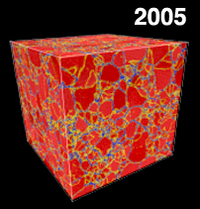ddcMD is an extremely scalable code for modeling particle dynamics. It evolved from a molecular dynamics code used to study the solidification of metals under pressure. It still has the capability to run simulations using the quantum-based Model Generalized Pseudopotential Theory (MGPT) interatomic potential as well as Embedded Atom Method (EAM) and Finnis-Sinclair potentials, demonstrating outstanding performance on 200,000+ CPU's in both strong scaling and weak scaling; i.e. running the same simulation on increasing numbers of processors (strong scaling) and running a simulation whose size increases with the number of processors (weak scaling). ddcMD also has the ability to handle long-ranged Coulomb interactions, and it has been used for simulations of electron-ion dynamics in dense plasmas. The code includes advances in high performance scalable I/O, fault tolerance, in-situ analysis, heterogeneous decomposition, and automatic, measurement-based load balancing. The outstanding performance of this code on the world's largest supercomputers and the innovations required to attain this performance have been recognized with two Gordon Bell Prizes and one Gordon Bell finalist.
- Simulation of materials: solidification, deformation, shocks
– Optimized MGPT forces - Simulations of plasmas: explicit electrons and ions
- Scales to 200,000+ CPU supercomputers
- 2005 Gordon Bell Prize: 100+ Tflop classical MD simulation of metal solidification
- 2007 Gordon Bell Prize: 1+ CPU-millennium fault-tolerant MD simulation of hydrodynamic instabilities
- 2009 Gordon Bell Finalist: novel treatment of long-range Coulomb forces enabling massively parallel simulations
- Developers: Glosli, Richards
References
J.N. Glosli, K.J. Caspersen, D.F. Richards, R.E. Rudd, F.H. Streitz, and J.A. Gunnels, "Micron-scale Simulations of Kelvin-Helmholtz Instability with Atomistic Resolution," in Proc. Supercomputing 2007 (SC07), Reno, NV, Nov. 2007.
D.F. Richards, J.N. Glosli, B. Chan, M.R. Dorr, E.W. Draeger, J.-L. Fattebert, W.D. Krauss, T. Spelce, F.H. Streitz, M.P. Surh, J.A. Gunnels, "Beyond homogeneous decomposition: scaling long-range forces on massively parallel systems," in Proc. Supercomputing 2009 (SC09), ACM, New York, NY, USA (2009), pp. 60:1–60:12.
F. R. Graziani et al., "Large-scale molecular dynamics simulations of dense plasmas: The Cimarron Project," High Energy Density Phys. 8, 105 (2012).
(http://dx.doi.org/10.1016/j.hedp.2011.06.010 )
F.H. Streitz, J.N. Glosli and M.V. Patel, "Beyond Finite-Size Scaling in Solidification Simulations," Phys. Rev. Lett. 96, 225701 (2006).
(http://link.aps.org/doi/10.1103/PhysRevLett.96.225701)






